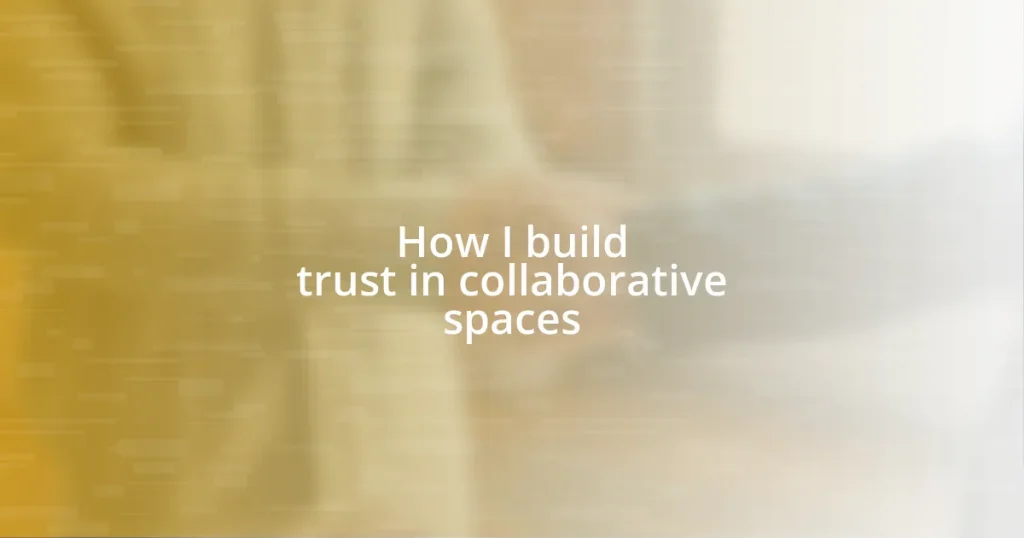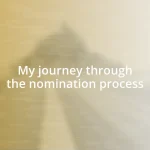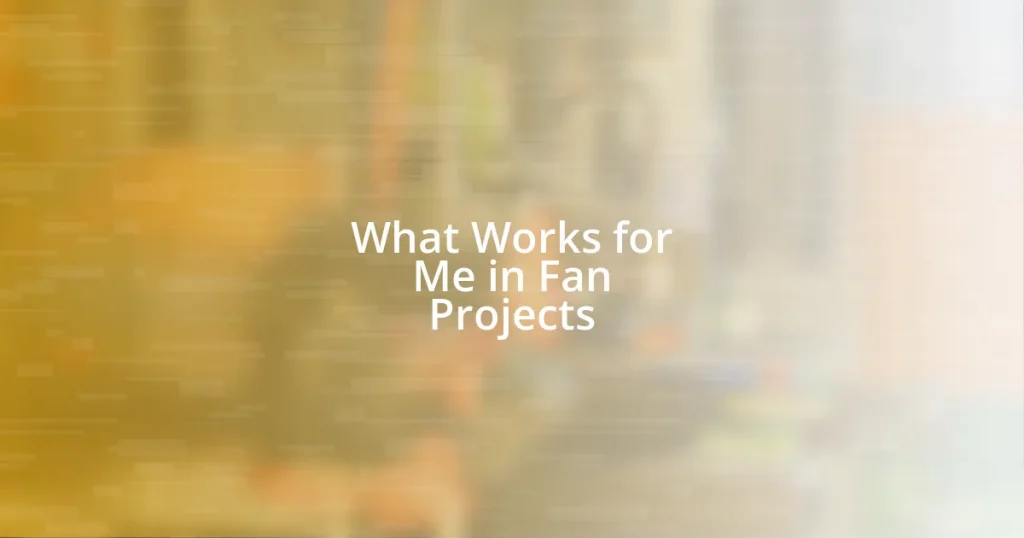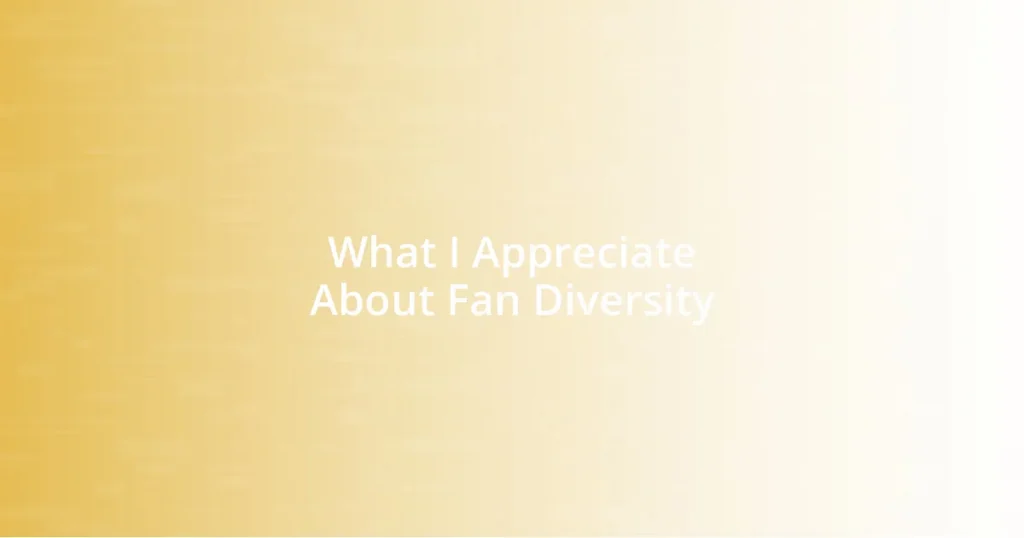Key takeaways:
- Collaborative spaces enhance creativity and innovation by fostering a culture of trust, open communication, and diversity of thought.
- Building rapport through social interactions, active listening, and shared experiences is essential for team cohesion and effective collaboration.
- Establishing clear roles, maintaining accountability, and celebrating achievements are crucial for nurturing a strong team dynamic.
- Regular evaluations of trust and collaboration levels through techniques like anonymous surveys and reflection sessions can strengthen team connections and improve productivity.

Understanding collaborative spaces
Collaborative spaces are environments designed to foster cooperation and creativity among individuals. I remember stepping into a vibrant co-working space for the first time, feeling the palpable energy in the air. It struck me how the layout—open desks, meeting areas, and cozy nooks—invited spontaneous conversations and brainstorming. Have you ever felt inspired simply by being around others who are equally driven? I certainly have.
These spaces go beyond mere physical design; they create a culture of trust and shared purpose. When colleagues gather to exchange ideas, something magical happens. I’ve experienced moments where a casual chat over coffee led to a breakthrough solution for a project. It’s as if collaboration is a catalyst, igniting creativity in ways I never anticipated. It makes me wonder: do we truly understand the power of these interactions?
Understanding collaborative spaces also means recognizing the diversity they encompass. People from different backgrounds and expertise come together, enriching the dialogue and driving innovation. I recall a project where my team’s diverse perspectives challenged the status quo, pushing us to explore solutions we may have otherwise overlooked. Is there not incredible strength in that variety? Each participant’s unique contribution can transform the collaboration into a more dynamic and rewarding experience.

Importance of trust in teams
Trust is the backbone of any effective team. From my experience, when team members trust each other, they’re more likely to share ideas openly and take risks without fear of judgment. I once worked on a project where trust among team members allowed us to tackle complex problems creatively. We felt comfortable voicing not just our ideas, but also our concerns, which led to richer discussions and ultimately a stronger final product.
The importance of trust manifests in various ways within teams:
- Enhanced collaboration: Trust fosters open communication and encourages team members to work together seamlessly.
- Increased productivity: When trust is present, individuals can focus on their tasks, leading to greater efficiency.
- Higher morale: A trusting environment boosts team spirit and job satisfaction, as members feel valued and respected.
- Resilience in challenges: Trust strengthens teams, enabling them to navigate conflicts and setbacks more effectively.
I believe that when we cultivate trust, we set the stage for true collaboration and innovation.

Building rapport with teammates
Building rapport with teammates is essential for creating a collaborative environment where trust can flourish. I can vividly recall an early experience in my career when I made an effort to get to know my teammates beyond just work-related interactions. I invited them to lunch and shared stories about our backgrounds and hobbies. This simple gesture helped break down barriers and established a friendly atmosphere, making it much easier for us to communicate and collaborate effectively.
When I reflect on my experiences, I realize that active listening plays a crucial role in building rapport. It’s about genuinely engaging with what your teammates are saying, asking questions, and showing that you value their input. I remember a time when a teammate was hesitant to share their ideas. By actively listening and encouraging them, I noticed their confidence grow, leading to our best brainstorming session yet. Why does this matter? It’s often the small actions that have the most significant impact on strengthening relationships.
Ultimately, building rapport is a continuous process that requires effort and commitment from all team members. Creating shared experiences and celebrating team successes helps forge deeper connections. I cherish the moments when our team came together after completing a challenging project; we celebrated with a casual get-together, reinforcing our bond. These experiences remind me that rapport isn’t a one-time achievement but a journey we embark on with our teammates.
| Building Rapport Strategy | Description |
|---|---|
| Social Interactions | Engaging in casual conversations to learn about teammates personally. |
| Active Listening | Genuinely focusing on teammates’ contributions to encourage their input. |
| Shared Experiences | Creating memories together, like celebrating achievements or team events. |

Techniques to foster open communication
Encouraging open communication requires intentional strategies that I’ve found invaluable. One approach I often use is to set regular check-ins where everyone can share their thoughts without interruption. I recall a time when our weekly meetings transformed from routine updates into vibrant discussions because we created a space where all voices mattered. Being vulnerable during these exchanges—sharing both successes and struggles—can really create a sense of unity and understanding among teammates.
Another technique that has proven effective for me is using open-ended questions during discussions. Instead of asking yes or no questions, I favor prompts that invite deeper reflection. For instance, “What do you think about this approach?” opens the floodgates for ideas. I remember facilitating a workshop where one question led to an unexpected breakthrough; it made everyone feel heard and valued, which is so important in maintaining an open dialogue. How often do we really explore the underlying thoughts within our teams?
Lastly, I aim to lead by example. I try to be transparent when I don’t know something or when I’ve made a mistake. By acknowledging my own vulnerabilities, I’ve noticed that teammates are more forthcoming with their own challenges. I once shared a misstep I made on a project; instead of judgment, I was met with collaborative problem-solving. This transparency fosters a culture where everyone feels safe to express themselves. Isn’t it fascinating how openness can spark creativity and innovation?

Strategies for shared decision making
When it comes to shared decision-making, I’ve found that establishing a collaborative framework is critical. One effective strategy is co-creating guidelines with the team. I remember working on a project where we all sat down and drafted a decision-making process together. This not only clarified expectations but also made everyone feel invested in the outcome. Have you ever experienced the difference between following imposed rules and creating them together? The latter creates a sense of ownership that really enhances collaboration.
Another technique I cherish is leveraging a consensus-building approach. I once facilitated a session where we had to choose a direction for a new initiative. Instead of voting, we engaged in a round-robin discussion, allowing each person to voice their thoughts fully. This process revealed underlying concerns and ideas that might have been missed in a simple vote. I still remember how one teammate’s input shifted our collective perspective dramatically. Isn’t it amazing how collective wisdom can emerge when everyone’s voice is amplified?
Finally, integrating regular feedback loops wraps it all up nicely. After a decision has been made, I like to organize follow-up discussions to reflect on the process and the outcome. I once initiated this practice after a major project, and the revelations that surfaced were eye-opening. Surprisingly, it not only enhanced our future decision-making but also reinforced trust as team members realized their insights were genuinely valued. How often do we take the time to analyze our decisions together? By doing so, we create an environment where learning and growth are continuous, fostering deeper connections among teammates.

Maintaining accountability within the group
I’ve come to realize that maintaining accountability within a group often hinges on clear roles and expectations. For instance, in a recent project, we created a shared document outlining each member’s responsibilities. When deadlines approached, I felt a tangible shift in how we interacted; the clarity made it easier for everyone to hold each other accountable. Don’t you find that when roles are well-defined, it’s much simpler to discuss progress without stepping on toes?
Another aspect I value deeply is fostering a culture of constructive feedback. In my experience, I’ve seen how checking in with each other regularly creates a sense of shared responsibility. I remember one time when a team member struggled to meet a deadline. Instead of pointing fingers, we circled back as a group to offer support, asking questions that guided him toward solutions. It made me realize that a group’s strength lies in its ability to lift one another, especially in challenging moments. How often do we take the time to not only share struggles but also to brainstorm together?
Lastly, celebrating achievements, both big and small, plays a crucial role in nurturing accountability. I’ve learned that recognizing when a teammate hits their mark not only motivates but also reinforces our commitment to the group. There was a moment last month when we wrapped up a challenging project, and we paused to toast to each contribution. It was that collective acknowledgment that made me appreciate every effort—as if to say, “We did this together.” Isn’t it invigorating to feel a part of something bigger than ourselves?

Evaluating trust and collaboration progress
Evaluating trust and collaboration progress is essential to ensure that everyone feels valued and connected. During a recent collaborative project, I made it a point to check in with team members halfway through our timeline. The discussions revealed areas where trust was strong and others where it needed nurturing. I remember a moment when a teammate hesitated to share their ideas, highlighting how crucial it is to create a safe space for open communication. Have you ever noticed how a simple conversation can reveal the underlying dynamics in a group?
One strategy I’ve employed is to use anonymous surveys to gauge how team members feel about trust levels and collaboration effectiveness. I once implemented this after a team retreat, and the insights I gathered were enlightening. Some responses indicated that while collaboration was high, trust still felt fragile for a few individuals. It’s like peeling back layers of an onion; each layer reveals something more. Wouldn’t it be beneficial to have a regular check on trust levels, much like we track project milestones?
I find that embedding reflection sessions into our workflow allows us to assess progress meaningfully. After completing a project phase, I like to sit down with the team and discuss what worked and what didn’t. One time, these discussions uncovered hidden frustrations that hadn’t been voiced before. The transparency that followed strengthened our bonds and made it easier to tackle the next phase together. How often do we allow ourselves the time to reflect on our collaborative journeys?















